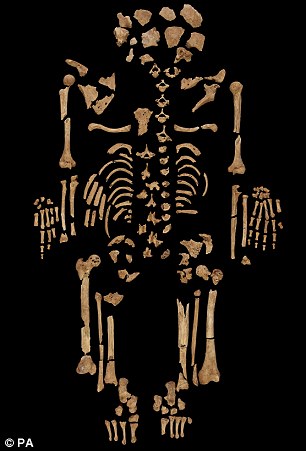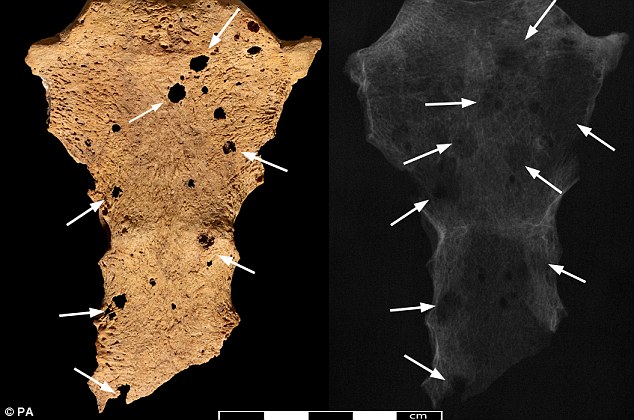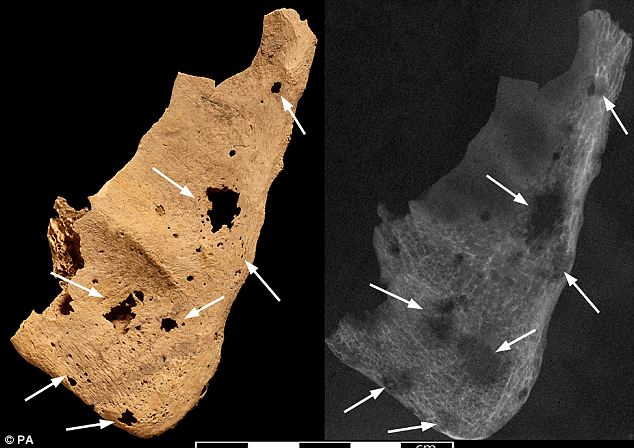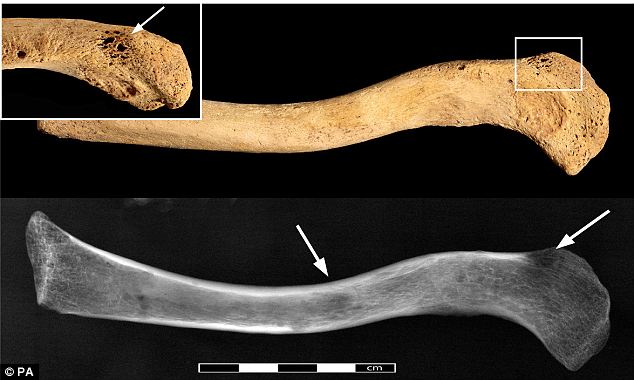
Archaeologists have found a complete 3,200-year-old skeleton, pictured, with cancer. The find could help show how the disease has evolved
Wealthy young man’s bones could help show how the disease evolved.
Archaeologists have found a complete 3,200-year-old skeleton with cancer and say the discovery could help show how the disease has evolved.
The remains of the wealthy man, believed to have been between 25 and 35 when he died, were found in a tomb close to the River Nile in Sudan last year.
The bones showed evidence of metastatic carcinoma – cancer which has spread from where it started.
Analysis proved it came from a malignant soft-tissue tumour and spread across large parts of the body, making it the oldest ‘convincing’ example of metastatic cancer ever found, the authors of the study said.
Researchers from Durham University and the British Museum said the discovery will help to explore underlying causes of cancer in ancient times and provide insights into the evolution of cancer in the past.
Although it is one of the leading causes of death today, it is extremely rare in archaeological finds compared to other detectable killers.
This has led scientists to conclude cancer is a product of modern lifestyles and increased longevity, but the discovery shows cancer did exist in the Nile Valley in 1200 BC.
Michaela Binder the lead author from Durham University’s Archaeology Department, said: ‘This may help us to understand the almost unknown history of the disease.

The sternum of the skeleton, believed to have belonged to a man aged between 25 and 35, pictured, shows evidence of cancer, highlighted by the arrows

Researchers found the bones at the Amara West site, 750km (466 miles), marked at A. Co-author, Dr Neal Spencer said: ‘From footprints left on wet mud floors, to the healed fractures of many ancient inhabitants, Amara West offers a unique insight into what it was like to live there – and die – 3,200 years ago’
‘We have very few examples [before] the first millennium AD.
‘We need to understand the history of the disease to better understand how it evolved and for that it is important to find more examples.’
The Austrian archaeologist added: ‘Our analysis showed that the shape of the small lesions on the bones can only have been caused by a soft tissue cancer even though the exact origin is impossible to determine through the bones alone.’
Binder found the bones at the once-populated Amara West site, 750km (466 miles) downstream from the modern capital of Khartoum.
Co-author, Dr Neal Spencer from the Department of Ancient Egypt and Sudan at the British Museum, said: ‘From footprints left on wet mud floors, to the healed fractures of many ancient inhabitants, Amara West offers a unique insight into what it was like to live there – and die – in Egyptian-ruled Upper Nubia 3,200 years ago.’

Signs of the metastatic cancer, shown via pathalogical lesions, were also found in the right scapula, pictured left. Tests using radiography and a scanning electron microscope provided clear imaging of these lesions, pictured right
Tests using radiography and a scanning electron microscope provided clear imaging of the lesions on the bones, with cancer metastases on the collar bones, shoulder blades, upper arms, vertebrae, ribs, pelvis and thigh bones.
The researchers could only speculate on the cause of the cancer, with theories being carcinogens such as smoke from wood fires, genetic factors or from an infectious disease caused by parasites.
To this day, the parasitic infection known as schistosomiasis is a cause of bladder cancer and breast cancer in men in the area.

The researchers could only speculate on the cause of the cancer, also found in the left clavicle, pictured, with theories being carcinogens such as smoke from wood fires, genetic factors or from an infectious disease caused by parasites
WHAT IS METASTATIC CANCER?
Metastatic cancer is cancer that has spread around the body.
Carcinoma is the most common form of cancer to occur in humans but it’s origin cannot always be determined.
The metastatic carcinoma found in this skeleton is of unknown origin – it is impossible to say where it started.
However, analysis proved it came from a malignant soft-tissue tumour and spread across large parts of the body, making it the oldest ‘convincing’ example of metastatic cancer ever found, the authors of the study said.
Although it is one of the leading causes of death today, it is extremely rare in archaeological finds compared to other detectable killers.
Written by Victoria Woollaston and published on The Daily Mail March 17, 2014, 2104.
FAIR USE NOTICE: This site contains copyrighted material the use of which has not always been specifically authorized by the copyright owner. We are making such material available in our efforts to advance understanding of environmental, political, human rights, economic, democracy, scientific, and social justice issues, etc. We believe this constitutes a ‘fair use’ of any such copyrighted material as provided for in section 107 of the US Copyright Law. In accordance with Title 17 U. S. C. Section 107, the material on this site is distributed without profit to those who have expressed a prior interest in receiving the included information for research and educational purposes. For more information go to: http://www. law. cornell. edu/uscode/17/107. shtml
